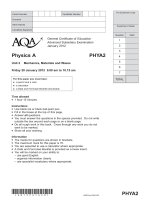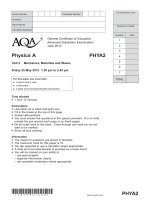AQA ANTH2 QP JUN13
Bạn đang xem bản rút gọn của tài liệu. Xem và tải ngay bản đầy đủ của tài liệu tại đây (94.73 KB, 4 trang )
General Certificate of Education
Advanced Subsidiary Examination
June 2013
Anthropology
Unit 2
ANTH2
Becoming a Person: Processes, Practices and Consequences
Wednesday 22 May 2013
1.30 pm to 3.00 pm
For this paper you must have:
l an AQA 12-page answer book.
Time allowed
l 1 hour 30 minutes
A
Instructions
l Use black ink or black ball-point pen.
l Write the information required on the front of your answer book. The Examining Body for this
paper is AQA. The Paper Reference is ANTH2.
l This paper is divided into two sections.
In Section A, answer all questions.
In Section B, answer one question.
l Do all rough work in your answer book. Cross through any work you do not want to be marked.
Information
l The marks for questions are shown in brackets.
l The maximum mark for this paper is 70.
l Questions carrying 10 marks or more should be answered in continuous prose. In these questions
you will be marked on your ability to:
– use good English
– organise information clearly
– use specialist vocabulary where appropriate.
H/Jun13/ANTH2
ANTH2
2
Section A
Answer all questions in this section.
Total for this section: 40 marks
Read Items A and B below and answer all the questions that follow.
Item A
Mauss claimed that the concept of ‘self’ is found in all human societies. Mauss was particularly
interested in the idea of personhood as a social category, which he felt had evolved and passed
through a number of different forms over time.
According to Mauss, there are two main concepts of personhood: the sociocentric and the
western. Mauss felt that the western concept of personhood was in fact a recent development.
Item B
For a long time, anthropologists have been interested in exploring the connections between
people and objects. They argue that, by exploring material culture, we can discover great
insights into the relationships between individuals and between groups. For example, Miller
(2001) argues that there is a strong connection between people’s possessions and their
identity.
Miller’s study focuses on the way in which material culture in the home allows individuals to
express and negotiate their identity. However, material culture in wider society, such as objects
that convey symbolic meanings, can also give us important information about how people
negotiate and maintain their identity.
0
1
0
2
0
3
0
4
Explain what is meant by ‘the western concept of personhood’ and illustrate your
(4 marks)
explanation with an example (Item A).
Identify and briefly explain two problems that anthropologists may face when trying to
(6 marks)
understand rites of passage.
Examine the ways in which gender roles are culturally constructed in two or more
(10 marks)
societies.
Using material from Item B and elsewhere, examine the ways in which material objects
(20 marks)
are used to express and negotiate identity in different societies.
H/Jun13/ANTH2
3
Section B
Answer one question from this section.
Total for this section: 30 marks
EITHER
0
5
Assess anthropological explanations of the different functions of rituals.
(30 marks)
OR
0
6
‘The causes of boundaries between social groups are always the same.’
(30 marks)
Assess this view.
END OF QUESTIONS
H/Jun13/ANTH2
4
There are no questions printed on this page
Copyright © 2013 AQA and its licensors. All rights reserved.
H/Jun13/ANTH2









